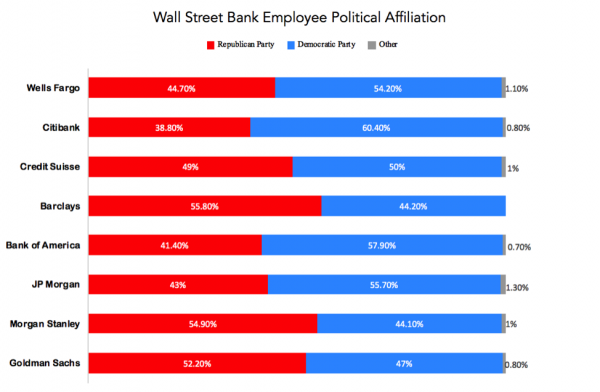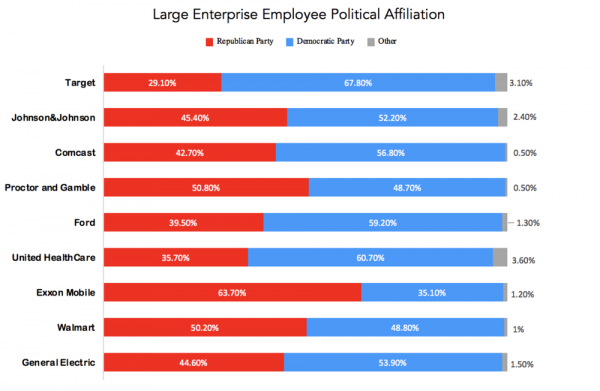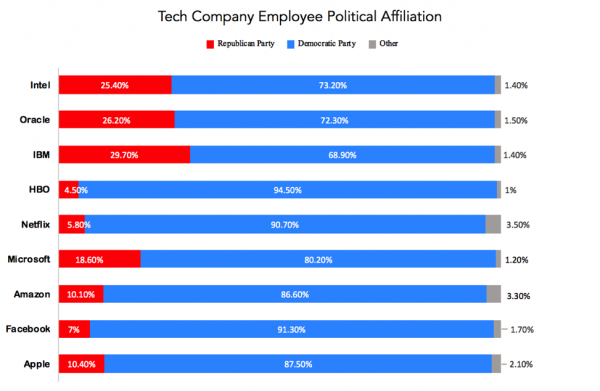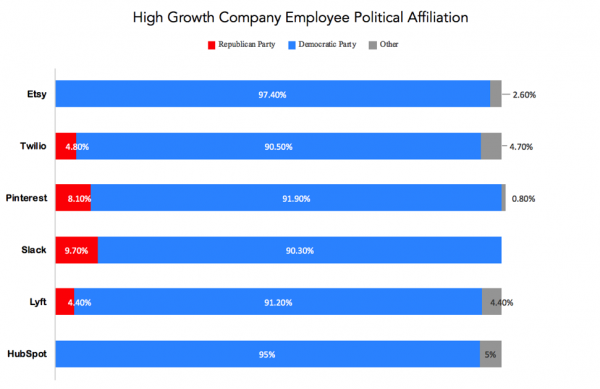While Companies Make Strides Toward Diverse Workplaces, Political Diversity Is Lacking in Tech

Despite increased pressure to create more inclusive workplaces, many companies still struggle with diversity. Preexisting lack of diversity in hiring teams, limited recruiting strategies that fail to reach broad candidate pools, unconscious biases, and a misguided focus on quotas rather than cultural change all pose significant challenges for diversity hiring initiatives.
It’s not that companies aren’t trying. Many organizations have implemented specific programs to improve workplace diversity and inclusion. Businesses are making concerted efforts to look for top talent in nontraditional spaces and tailoring job posts to attract more diverse candidate pools. Some business have even dropped four-year degree requirements for certain jobs in an effort to tap new audiences of job seekers. Companies are diversifying their interview panels and implementing blind recruitment processes, all in an effort to remove unconscious bias and let candidates’ skills shine, regardless of their backgrounds.
Why Diversity Matters
Why are companies pouring so much effort into diversity and inclusion initiatives? To put it simply, the benefits of a diverse workforce extend far beyond good PR.
For starters, more diverse companies are better able to attract top talent, as 67 percent of job seekers take diversity into account when considering employment market opportunities. Diversity can also drive employee engagement and reduce turnover. Employees who feel accepted and valued are happier and less likely to leave.
Deloitte found inclusive companies perform 80 percent better than their less inclusive counterparts. A more diverse workforce also has access to a wider range of perspectives, which increases innovation. According to Josh Bersin, inclusive companies are 70 percent more likely to be innovation leaders.
It’s clear that businesses should be thinking about diversity, but that raises another important question: What does diversity look like?
Traditionally, people have thought of diversity largely in terms of race, ethnicity, and gender. However, these may not be the only areas of diversity in which businesses are falling short. Recent complaints from conservative employees about perceived liberal biases at their companies suggest political diversity may be lacking in certain industries as well.
Political and Ideological Diversity
Is political diversity really an issue in some industries, or is it all bluster? We aggregated political donation data from Zippia to see how businesses from different industries and categories stack up in terms of political diversity. Here’s what we found:

While Wall Street has a reputation for being a bit on the conservative side, these banks are highly politically diverse. In fact, almost all firms hover around a 50/50 split between the two parties. Citibank has the most significant majority, with 60.4 percent of its employees being Democratic Party supporters and 38.8 percent aligning with the Republican Party.

The largest companies companies also seem to welcome political diversity among their employees. While they are less balanced than the Wall Street banks, these big companies have high representation of both political parties. The largest majority is at Target, where a little more than two-thirds of employees are Democrats.

The tech industry shows signs of a significant lack of political diversity, as all of the featured companies are predominantly Democrat. HBO has the least political diversity, with almost 95 percent of its employees reported to be Democrats. Employees’ political affiliations are most varied at IBM, but there is still a nearly 70 percent liberal majority. These numbers are likely not a surprise to anyone in the world of tech.

These high-growth companies show extreme political homogeneity. The most politically diverse company here is Slack, but 90 percent of the employees are still Democrats. Two of these companies, Etsy and HubSpot, lack Republican representation entirely.
So What?
While larger companies and Wall Street banks are more mixed in the political leanings of their employees, high-growth businesses and tech companies appear to lack political diversity. Companies in both categories have very limited representation of Republican employees.
It is also significant that the largest Democratic majority (97.4 percent at Etsy) is much higher than the largest Republican majority (63.7 percent at Exxon Mobil). Furthermore, in all four categories, the largest majorities are Democratic majorities. In other words, companies that are the least politically diverse tend to be majority Democratic.
Overall, it seems as though the tech industry and many high-growth companies have a ways to go in terms of political diversity. Improving political diversity in these industries is important because having such political homogeneity can be isolating for the few employees who do have differing views. These feelings of isolation can lead to unhappiness and, ultimately, hurt your employer brand in the long run. Also, employees with different political affiliations may have different ways of thinking and unique approaches to problem-solving that could allow them to offer some invaluable insights.
Ultimately, talented people come from all racial, ethnic, gender, and even political backgrounds. Cultivating diverse perspectives allows your business to grow and thrive.
While political diversity is something your business should strive for, support for political diversity should never be understood as allowing any form of intolerance or discrimination. No matter how your employees vote, your company’s ultimate goal should be to foster a culture of respect and inclusion by acknowledging an individual’s right to their own opinion while ensuring all views that are expressed are respectful of all people. HR pros and company executives alike should aim to create workplace environments where people are treated as equals regardless of their differences.
A version of this article originally appeared on the SelectSoftware blog.
Phil Strazzulla is the founder of SelectSoftware.

